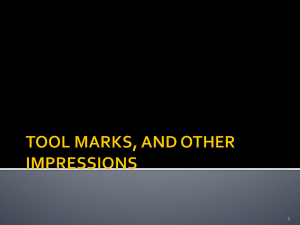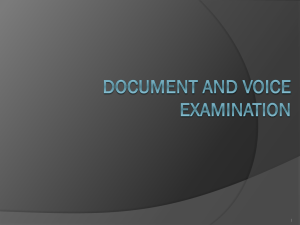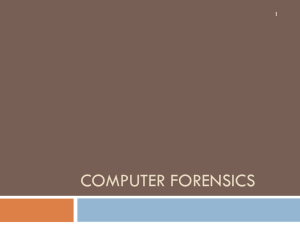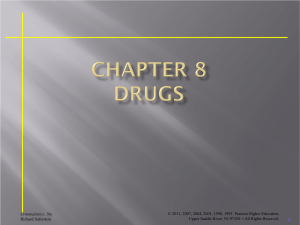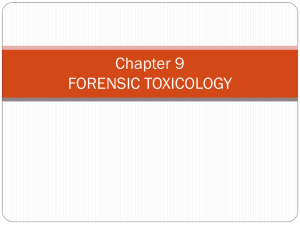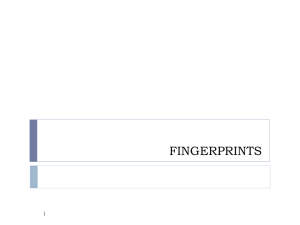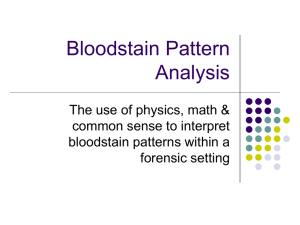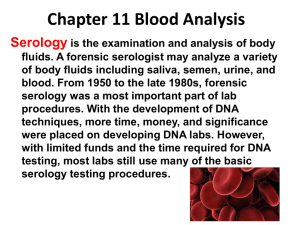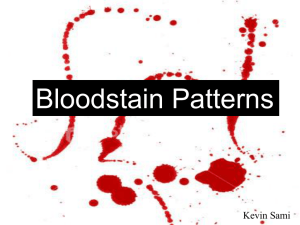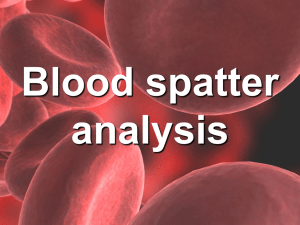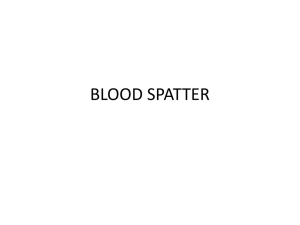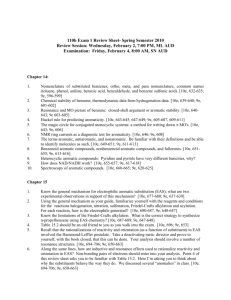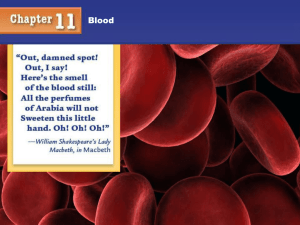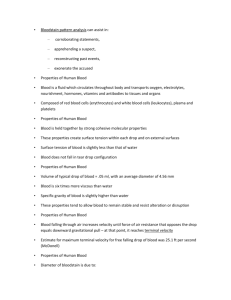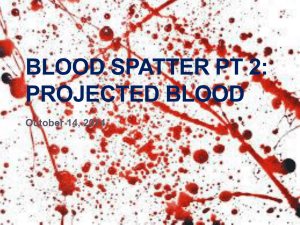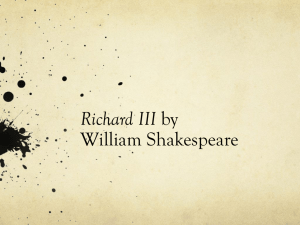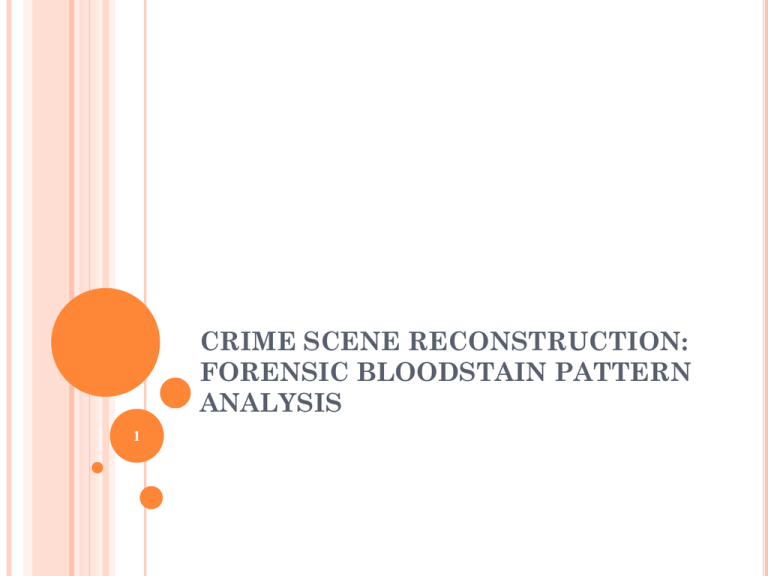
CRIME SCENE RECONSTRUCTION:
FORENSIC BLOODSTAIN PATTERN
ANALYSIS
1
CRIME SCENE RECONSTRUCTION
The
method used to support a likely
sequence of events by the observation and
evaluation of physical evidence, as well as
statements made by those involved with the
incident, is referred to as reconstruction.
Crime-scene reconstruction relies on the
combined efforts of medical examiners,
criminalists, and law enforcement personnel
to recover physical evidence and to sort out
the events surrounding the occurrence of a
crime.
2
Criminalistics, 10e
Richard Saferstein
© 2011, 2007, 2004, 2001, 1998, 1995 Pearson Higher Education,
Upper Saddle River, NJ 07458. • All Rights Reserved.
12-
STAIN PATTERNS OF BLOOD
The
crime scene investigator must
remember that the location, distribution,
and appearance of bloodstains and
spatters may be useful for interpreting
and reconstructing the events that
produced the bleeding.
Surface texture and the stain’s shape,
size, and location must be considered
when determining the direction, dropping
distance, and angle of impact of a
bloodstain.
Criminalistics, 10e
Richard Saferstein
3
© 2011, 2007, 2004, 2001, 1998, 1995 Pearson Higher Education,
Upper Saddle River, NJ 07458. • All Rights Reserved.
12-
STAIN PATTERNS OF BLOOD
Surface texture is of paramount importance. In
general, the harder and less porous the surface, the
less spatter results.
The direction of travel of blood striking an object may
be discerned because the pointed end of a bloodstain
always faces its direction of travel.
The impact angle of blood on a flat surface can be
determined by measuring the degree of circular
distortion. At right angles the blood drop is circular,
as the angle decreases, the stain becomes elongated.
The origin of a blood spatter in a two-dimensional
configuration can be established by drawing straight
lines through the long axis of several individual
bloodstains. The intersection or point of convergence
of the lines represents the origin point.
Criminalistics, 10e
Richard Saferstein
4
© 2011, 2007, 2004, 2001, 1998, 1995 Pearson Higher Education,
Upper Saddle River, NJ 07458. • All Rights Reserved.
12-
STAIN PATTERNS OF BLOOD
A shooting may leave a distinct gunshot spatter
pattern. This may be characterized by both forward
spatter from an exit wound and back spatter from
an entrance wound.
The location of injury, the size of the wound
created, and the distance between the victim and
the muzzle of the weapon all affect the amount of
back spatter that occurs.
A cast-off pattern is created when a blood-covered
object flings blood in an arc onto a nearby surface.
Arterial spray spatter is created when a victim
suffers an injury to a main artery or the heart.
Commonly, the pattern shows large spurted stains
for each time the heart pumps.
5
Criminalistics, 10e
Richard Saferstein
© 2011, 2007, 2004, 2001, 1998, 1995 Pearson Higher Education,
Upper Saddle River, NJ 07458. • All Rights Reserved.
12-
STAIN PATTERNS OF BLOOD
A pattern created by blood that is expelled from the
mouth or nose from an internal injury is called an
expirated blood pattern.
A void is created when an object blocks the
deposition of blood spatter onto a target surface or
object.
When an object with blood on it touches one that
does not have blood on it, this produces a contact or
transfer pattern.
Examples of transfers with features include
fingerprints, handprints, footprints, footwear
prints, tool prints, and fabric prints in blood.
Patterns made by drops or large amounts of blood
6
flowing by the pull of gravity are called flows.
Criminalistics, 10e
Richard Saferstein
© 2011, 2007, 2004, 2001, 1998, 1995 Pearson Higher Education,
Upper Saddle River, NJ 07458. • All Rights Reserved.
12-
STAIN PATTERNS OF BLOOD
A pool of blood occurs when blood collects in a level
(not sloped) and undisturbed place.
The edges of a stain will dry to the surface,
producing a phenomenon called skeletonization.
A trail pattern is a series of drops that are separate
from other patterns, formed by blood dripping off
an object or injury.
7
Criminalistics, 10e
Richard Saferstein
© 2011, 2007, 2004, 2001, 1998, 1995 Pearson Higher Education,
Upper Saddle River, NJ 07458. • All Rights Reserved.
12-
DOCUMENTING BLOODSTAIN EVIDENCE
Investigators should note, study, and photograph
each pattern and drop of blood to accurately record
the location of specific patterns and to distinguish
the stains from which laboratory samples were
taken.
The investigator should create photographs and
sketches of the overall pattern to show the
orientation of the pattern to the scene.
Two common methods of documenting bloodstain
patterns are the grid method and the perimeter
ruler method.
8
Criminalistics, 10e
Richard Saferstein
© 2011, 2007, 2004, 2001, 1998, 1995 Pearson Higher Education,
Upper Saddle River, NJ 07458. • All Rights Reserved.
12-
Figure 12-1 A laser beam is used to determine the search area for the
position of a shooter who has fired a bullet through a window and
wounded a victim. The bullet path is determined by lining up the
victim’s bullet wound with the bullet hole present in the glass pane.
Criminalistics, 10e
Richard Saferstein
9
© 2011, 2007, 2004, 2001, 1998, 1995 Pearson Higher Education,
Upper Saddle River, NJ 07458. • All Rights Reserved.
12-
Figure 12–7 Illustration of stain convergence on a two-dimensional
plane. Convergence represents the point from which the stains
emanated. Courtesy Judith Bunker, J. L. Bunker & Assoc., Ocoee, FL
Criminalistics, 10e
Richard Saferstein
10
© 2011, 2007, 2004, 2001, 1998, 1995 Pearson Higher Education,
Upper Saddle River, NJ 07458. • All Rights Reserved.
12-
REVIEW QUESTIONS (1-5)
Why is the surface texture of paramount importance
in the interpretation of bloodstain patterns?
How can an investigator tell the direction of travel of
blood from the shape of a bloodstain?
What is the difference between the shape of a
bloodstain that impacts a surface at a low angle and
one that impacts at a higher angle?
What is the difference between forward spatter and
back spatter? Which is more likely to be deposited on
the object or person creating the impact?
In general, as both the force and velocity of impact
increase, what happens to the diameter of the
resulting blood droplets?
Criminalistics, 10e
Richard Saferstein
11
© 2011, 2007, 2004, 2001, 1998, 1995 Pearson Higher Education,
Upper Saddle River, NJ 07458. • All Rights Reserved.
12-
REVIEW QUESTIONS 6-13
Why might investigators overlook some high-velocity
spatter?
Define the terms area of convergence and area of origin and
explain what kind of information each reveals to an
investigator.
Name three factors that affect the amount of backward
spatter produced by a gunshot wound.
What is the drawback effect? How is it helpful to an
investigator?
What determines the size of blood drops in a cast-off
pattern? Explain.
What is expirated blood? Name two ways to distinguish
expirated blood from other types of bloodstains.
What is a void pattern? How might a void pattern be
useful to investigators?
What is a transfer pattern? How is a simple transfer
pattern created?
Criminalistics, 10e
Richard Saferstein
12
© 2011, 2007, 2004, 2001, 1998, 1995 Pearson Higher Education,
Upper Saddle River, NJ 07458. • All Rights Reserved.
12-
REVIEW QUESTION 14-18
How does the first transfer pattern in a series
differ from subsequent ones?
What is a flow pattern? What should one surmise
if a flow found on an object or body does not
appear consistent with the direction of gravity?
How can pools of blood aid in reconstructing a
crime scene?
Explain how the shape of stains in a trail
pattern can help investigators determine the
direction and speed at which a person was
moving.
Name and describe two methods for
documenting bloodstain patterns.
Criminalistics, 10e
Richard Saferstein
13
© 2011, 2007, 2004, 2001, 1998, 1995 Pearson Higher Education,
Upper Saddle River, NJ 07458. • All Rights Reserved.
12-



